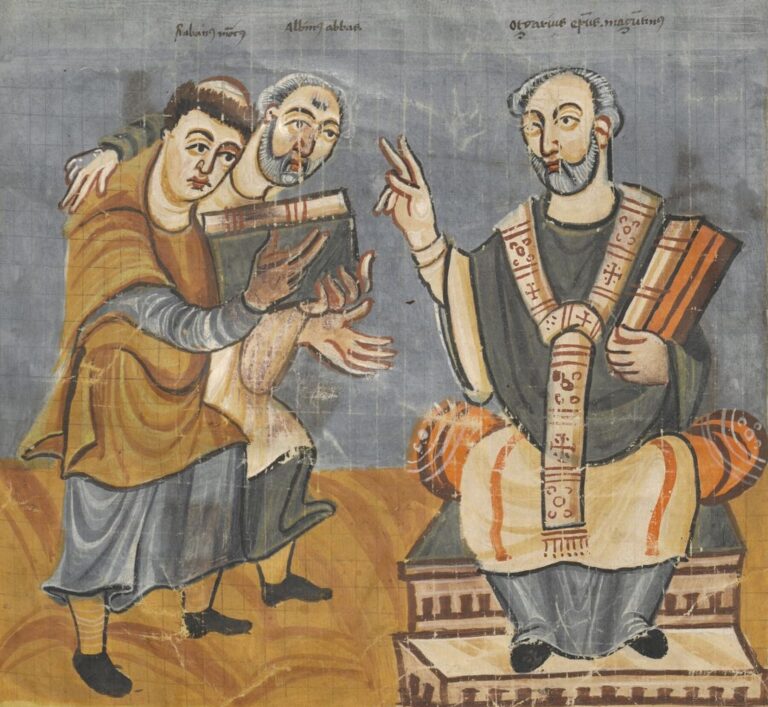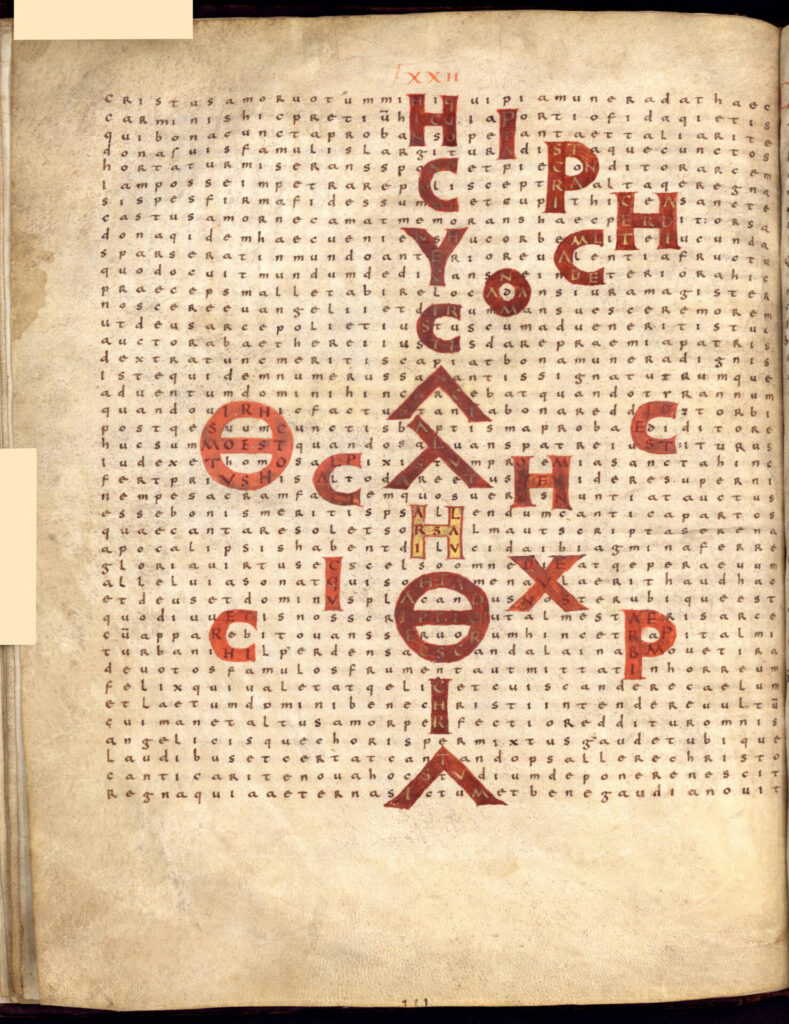De Laudibus Sanctae Crucis
A modern interpretation of Hrabanus Maurus’s Chi-Rho figure poem
Christ in the Grid: A Visual Poem of Sacred Complexity
In the early 9th century, the Benedictine monk Hrabanus Maurus created one of the most intellectually and spiritually ambitious poetic works of the Middle Ages: De Laudibus Sanctae Crucis (“In Praise of the Holy Cross”). This extraordinary manuscript consists of 28 figure poems (carmina figurata), where sacred text becomes visual art. Each page is a carefully constructed grid of Latin verse, with certain letters highlighted to reveal hidden shapes—symbols of Christ and the Cross.
One of the most striking examples takes the form of a Chi-Rho (ΧΡ), the ancient monogram for Christ, composed of the first two letters of ΧΡΙΣΤΟΣ (Christos) in Greek. Within this grid, larger red-highlighted letters form the monogrammatic cross. But this design is more than ornamental—it encodes a network of names, numbers, and theological ideas.
This modern interpretation recreates Hrabanus’s original layout using EB Garamond, balanced spacing, and a warm, parchment-inspired color palette. This page presents the poem’s historical context, the full Latin and English text, visual comparisons, and a breakdown of the hidden messages embedded in the layout.
About De Laudibus Sanctae Crucis

De Laudibus Sanctae Crucis was composed around the year 810, while Hrabanus was a monk at Fulda Abbey in the Carolingian Empire. A student of Alcuin of York and later Archbishop of Mainz, Hrabanus was one of the foremost scholars of his age. His work is considered a high point of Carolingian learning, combining literature, art, and theology.
These visual poems integrate text and image through geometric grids that embed theological symbols, often taking the form of crosses or Christograms. This reflects the medieval tradition of multi-layered interpretation in Christian art and Scripture—what the Church Fathers called the four senses: literal, allegorical, moral, and anagogical.
The Chi-Rho poem is among the most complex in the collection. It incorporates Greek inscriptions, Latin verse, and biblical numerology. The highlighted Greek names for Christ—ΣΩΤΗΡ (Soter, “Savior”), ΙΗΣΟΥΣ (Jesus), and ΑΛΗΘΕΙΑ (Alētheia, “Truth”)—are inscribed across the Chi-Rho shape, each loaded with symbolic weight.
Medieval sources associated the P (Rho) with 1260 days, referencing the period of Christ’s ministry (Revelation). The X (Chi) symbolically marked 1335 days, a number from Daniel’s prophecy, seen as the time after the Antichrist leading to the end of days. The result is a fusion of poetic form, graphic design, and theology—long before any of those terms existed in the modern sense.
Manuscript Context and Visual Comparison
The original manuscripts of De Laudibus Sanctae Crucis survive in several copies. The most famous is the Codex Sangallensis 100, held at the Abbey of Saint Gall in Switzerland. Another significant version is in the Vatican Library (Reg.lat.124). These manuscripts are remarkable for their visual precision: gridded layouts, rubricated initials, and intricate illuminated detail.
Below is a side-by-side comparison of the original Chi-Rho page (as preserved by the U.S. Library of Congress) and my digital reinterpretation. The aim was to retain the harmony and density of the original while enhancing legibility and visual clarity through modern typographic tools.


The structure is built entirely from the Latin poem’s letter grid. Large, red Greek letters form a Chi-Rho shape, intersected by other characters that complete a hidden sacred message. The palette, type, and framing aim to amplify, not reinterpret, the original meaning.
Latin Poem and English Translation
Full Latin Text of the Poem:
Christus amor votum mihi, qui pia munera dat haec
Carminis, hic pretium, hic via, portio fida quietis:
Qui bona cuncta probans ope, tanta et talia rite
Dona suis famulis largitur, ad istaque cunctos
Hortatur miserans, spondet pie conditor arcem
Jam posse impetrare poli sceptra, altaque regna,
Si spes, firma fides summi, et cupit hic ea sancte
Castus amor, nec amat memorans haec perditus orsa.
Dona quidem haec veniens huc orbem lite jucunda
Sparserat in mundo anteriore valentia fructu.
Quo docuit mundum dedicans, ne in deteriora hic
Praeceps mallet abire loca, dans jura magister
Noscere Evangelii, et dirum mansuescere morem.
Ut Deus arce poli et justus, cum advenerit istuc
Auctor ad aetherei justis dare praemia Patris,
Dextra tunc meritis capiat bona munera dignis.
Iste quidem numerus sanantis signat utrumque
Adventum Domini, hinc arcebat quando tyrannum,
Quando vir hic factus tanta bona reddidit orbi,
Postque suum cunctis baptisma proba edidit ore.
Hunc summo est quando salvans Patre justus iturus
Judex, et homo sal pix istum praemia sancta hinc
Fert prius hic alto dare, et usque videre superni
Nempe sacram faciem: quos verus nuntiat auctus
Esse bonis meritis psallendum cantica partos:
Quae cantare solet sors alma, ut scripta serena
Apocalypsis habent, dilucida ibi agmina ferre
Gloria, virtus, excelso omne die atque per aevum
Alleluia sonat, quis oh tamen aula erit haud hac
Et Deus et Dominus placandus noster ubique est,
Quod juvet iis nos scriptio, ut alma est aeris arce
Cum apparebit ovans servorum hinc, et rapit almi
Turba nihil perdens ac scandala inabmovet ira
Devotos famulos frumenta ut mittat in horreum
Felix qui valet atque licet cui scandere coelum,
Et laetum Domini bene Christi intendere vultum:
Cui manet altus amor perfectio redditur omnis.
Angelicisque choris permixtus gaudet ubique
Laudibus, et certat cantando psallere Christo.
Cantica rite nova hoc studium deponere nescit:
Regina quia aeterna sic tum et bene gaudia novit.
Full English Translation:
Christ is love, my vow, who gives these holy gifts.
Of the poem—here is its reward, here the path, here the faithful share of rest.
He who, approving all good things with power, rightly grants such great and noble gifts
To his servants, and to these things he urges all.
He exhorts with mercy, the pious Creator promises the citadel—
That now the scepters of heaven and the high kingdoms may be obtained,
If hope, firm faith in the Most High, and holy longing desire them,
And chaste love; for one does not truly love if, forgetting these, he is lost in beginnings.
Indeed, these gifts, coming into the world with joyful peace,
Were scattered in the earlier world with powerful fruitfulness.
By which he taught the world, dedicating it, so that it would not fall into worse things—
[So that] it would not rush headlong into those places; the teacher gave the law
To know the Gospel, and to soften the harsh way of life.
So that God from the citadel of heaven—the Just One—when he comes,
As the Author, may give the rewards of the heavenly Father to the just.
May the right hand then receive good gifts, deserved by the worthy.
This number of the Healer marks both comings
Of the Lord: when he restrained the tyrant,
When he, made man, restored such good things to the world,
And after his baptism, declared it with faithful speech to all.
And when the Savior is about to go to the Father Most High, the Just Judge—
Both man and the seal of salvation—brings holy rewards
To give from on high, and forever to behold the face of the Most High:
Namely, the sacred face, which the true one declares
Is to be praised with hymns, for those who have grown in good merits:
Which the blessed lot is accustomed to sing, as the serene writings
Of the Apocalypse proclaim—to bear shining hosts
Of glory and power to the Most High, every day and through all ages.
Alleluia resounds—oh, who then will be in that hall, and not here?
God and our Lord, to be appeased, is present everywhere,
May this writing help them, as it is nurturing in the fortress of the air,
When he appears rejoicing, and the crowd of the holy
Carries away [his own], losing nothing, and removes scandals with steadfast wrath,
So that he may send his devoted servants—like grain—into the granary.
Happy is the one who is able and permitted to ascend to heaven,
And to rightly behold the joyful face of the Lord Christ.
For whom high love remains, and all perfection is given.
And, joined with angelic choirs, he rejoices everywhere
In praises, and strives to sing in psalm to Christ.
This zeal does not know how to set aside the proper new songs,
For the eternal Queen thus knows well the joys to come.
Decoding the Chi-Rho Structure and Hidden Inscriptions
Hrabanus’s Chi-Rho design is not merely decorative—it is a framework of meaning. Each of the large red Greek letters helps spell out names of Christ or embedded Latin verses.
🔠 Christ’s Names in Greek:
In the arms of the Chi (X): ΘΕΟΣ (God), ΧΡΗCΤΥC (Christ), ΙΗCΥC (Jesus)
In the bowl and stem of the Rho (P): ΣΩΤΗΡ (Savior), ΙΗΣΟΥΣ (Jesus), ΑΛΗΘΕΙΑ (Truth)
📝 Hidden Latin Verses:
Encoded within the letter outlines are Latin poems such as:
Nam alma decet radiant scripta hinc quod nomine Christi
“For it is fitting that these radiant writings shine with the name of Christ.”Sancta salutaris laudat haec scriptio Christum
“This sacred, saving text praises Christ.”Christus homo est placidus, nempe arbiter hic quoque mundi est
“Christ is man, gentle indeed; and judge—he also rules the world.”
This visual-poetic interplay elevates the work beyond ornament or acrostic—it becomes a multi-layered meditation on the nature of Christ.
🔢 Numerical Symbolism:
P (Rho) = 1260 days → Christ’s public ministry (Revelation)
X (Chi) = 1335 days → Time after the Antichrist, before judgment (Daniel)
In Hrabanus’s design, theology is encoded in form—a devotional geometry in which every element holds symbolic weight.
My Interpretation and Artistic Choices
My goal was to present Hrabanus’s poem with faithfulness and clarity, using modern design to illuminate ancient meaning.
The grid was rebuilt from scratch, and the Latin transcribed manually.
EB Garamond was chosen for its elegance and historical feel—echoing early print culture.
The Greek letters were redrawn digitally in bold contrast, forming the sacred core of the visual.
The palette blends warm parchment tones and deep reds, evocative of medieval manuscripts without copying them.
The result is both homage and interpretation: a devotional design rooted in tradition, made legible for today’s viewers—whether scholars, collectors, or those drawn to sacred art.
Thank you for Visiting
This project is part of my ongoing effort to revive historical book art through digital craftsmanship. If you’d like to see more or support this work, please explore the full collection or follow along on Instagram or Fine Art America.
